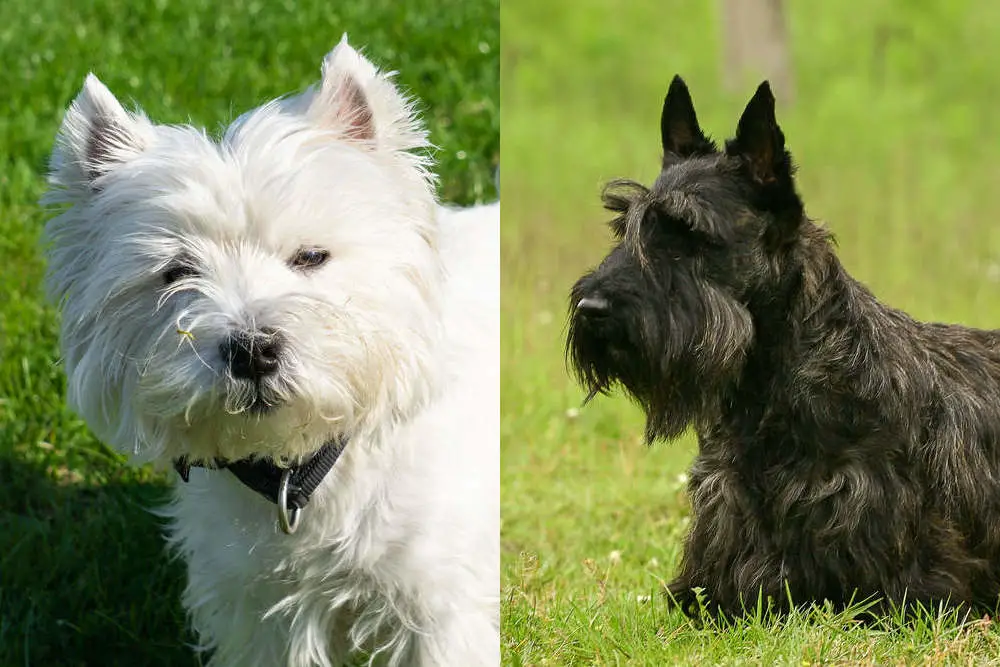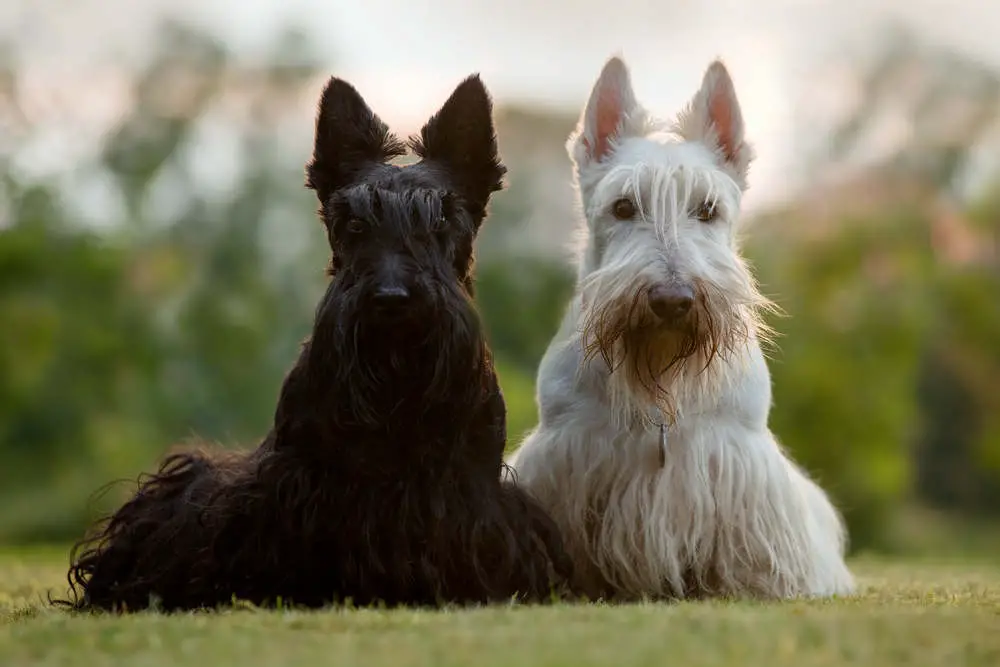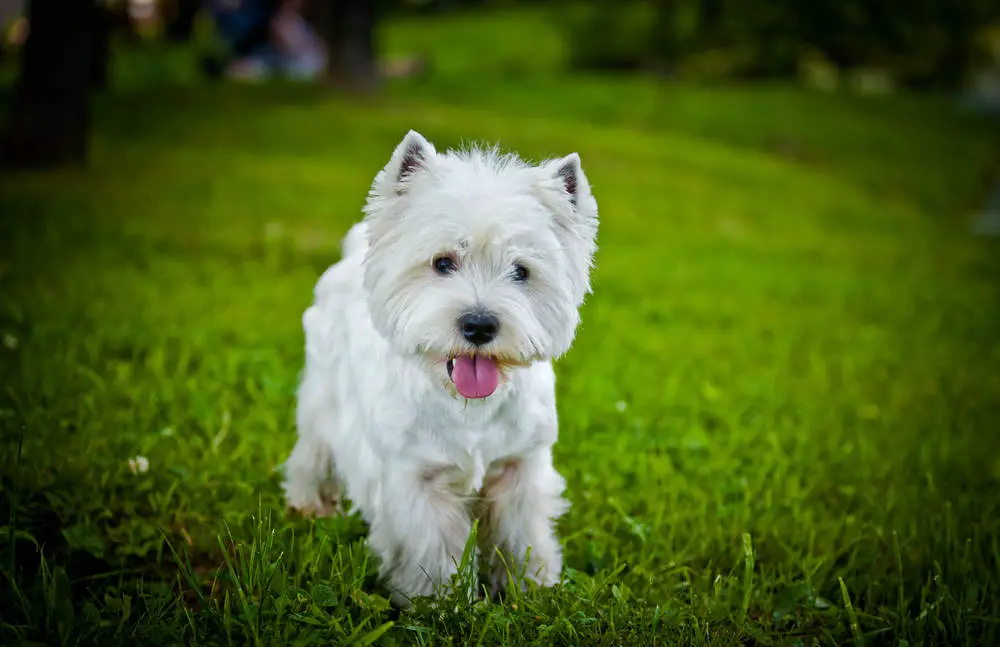
Small, fluffy and hailing from Scotland, you might think that the West Highland White Terrier and the Scottish Terrier are all the same, but that is where you are wrong!
Read on to find out what makes these two breeds so different and why.
Appearance
One of the most distinctive differences between a Westie and Scottie’s appearance is the color of their coats. A Westie is always white in color, although there are few rare off-white or wheaten colored ones. Meanwhile, a Scottie is never white.
Scotties typically come in colors of black, brindle or wheaten. Brindle is when the fur’s individual strands have two colors in them, creating patterns on the coat.
Another major difference is the shape of their muzzle. While a Westie has a short snout proportionate to its face and body, the Scottie has a pronounced longer muzzle that is as big as the rest of its face, giving him a rather endearing old-man look.
Westies also have shorter ears that are almost perfectly triangular in shape with no pricks or indentations at the outline. These ears are also always erect. The Scottie has bigger pricked ears with a softer triangular shape, and is born with floppy ears that stand up around 10 weeks of age.
Their body shapes also differ greatly as the Scottie is longer, shorter and heavier boned than the Westie. Comparing the two, the Westie looks more proportionate while the Scottie is longer than its wider.
Another difference has to do with their expression and face shapes. The Westie has a generally softer and rounded face with grooming enhancing that shape, like in the teddy-bear cuts you may have seen on social media.
The Scottie, however, has a more rectangular face due to its elongated muzzle and grooming tends to enhance the beard and bushy eyebrows appearance, giving the dog a distinct impression of being a curious grandfather.
There are subtle differences in their sizes as well, as the Westie is the smaller of the two at 15 to 20 pounds in weight while the Scotties come in between 18 to 22 pounds.
However, because of their different body shapes, the Westie is usually taller than the Scottie by a couple of inches. Westies are usually 10 to 11 inches tall from the shoulder to the ground while the Scotties are mostly around 10 inches tall.
Related: Scoland Terrier (Westie Scottie Mix Breed)
History
Now that you know how to tell a Scottie and a Westie apart at a glance, how about diving into their fascinating history? While both may be from the Scottish Isles, they were bred for very different purposes and with different motivations.
Take a look to find out why is it that Westies are nearly always white, and why a Scottie is a granddaddy in more than just looks!
Scottish Terrier

The Scottie is a bit of a weird one among purebred dogs because its origins are a little murky and mostly unknown. This is because it is one of the oldest dog breeds alive today!
It’s so old that is believed that Pliny the Elder was referring to an ancient version of Scotties when describing the Roman Invasion of Britain in 55 BC! After that, a more near relative was mentioned in ‘A History of Scotland’ by Don Leslie in 1436.
Following this time, different terriers sprung up along the Scottish Isles, all of which were descendants or variants of the original Scottish Terrier. It was finally in the 1800s that the Scottish Terrier was properly specified and included in kennel clubs along with the different variants it helped breed.
The Scottie is actually the foundation breed for all terriers available today, including the Westie!
West Highland White Terrier
As mentioned before, we know that the Westie is a descendant of the Scottie breed. However, did you know that in their early years, Westies used to be available in a variety of shades?
The white standard we know today became popular in the 1700s thanks to the efforts of Col. Edward Donald Malcolm, of Poltalloch in Argyllshire. This is why this breed is also called the Poltalloch Terrier sometimes!
He noticed that landowners often ended up accidentally shooting their terriers, mistaking them for foxes because of their size and reddish-brown coats.
So he bred a pure white version and it became so popular that the other strains eventually died out, leaving only the white version we know today.
Also Read: Westie vs Yorkie
Temperament
You might be thinking that since both the Scottie and the Westie share history, they must share personality traits too, but that is not the case. The two are completely different when it comes to temperament, in many ways.
Scottish Terrier
The Scottish Terrier is a more independent dog, who likes to do his own thing. As they were originally bred to function on farms without human supervision, they are highly intelligent.
However, they also have a high prey drive, making them unsuitable for homes with smaller pets. It is also not advised to have Scotties in homes with very young children as this dog likes to stand up for itself and will not tolerate unprovoked poking and prodding.
They are wary of people outside of their family and tend to have a more direct master and dog relationship with one or two members of the family only.
Surprisingly, the Scottie is not a yapper like other terriers. It has a pronounced bark that it uses only when necessary and is generally a calm, collected dog.
West Highland White Terrier

The Westie by comparison is a much more sociable and people-loving breed. They were bred to work closely with humans in eradicating rats and foxes, and are great at following directions.
They can be possessive, especially about their food and toys, so they are also not advisable for households with very young children. However, they are very family oriented and will do great in homes where the children are old enough to understand to not mess with its stuff!
Westies are naturally sociable towards humans and are quick to warm up to strangers and other dogs if socialized properly during their early years.
These dogs are the yappers and you will hear them being excited about different things throughout the day! Probably not the best dog for an apartment block.
Also Read: Westie vs Maltese
Care
The care needed for the Scottie and the Westie is similar in many ways. Since they have a similar dual coat, they will need regular grooming to avoid matting and tangling. (See our guide on choosing a brush for Westies.)
A dual coat is when the top part of the coat, at the back and sides, is different from the underside coat, which is typically softer and fluffier.
A Scottie’s topcoat is typically wiry and shaggy and its undercoat is soft while a Westie’s topcoat is straight and uniform in length with a dense undercoat.
When it comes to exercise, neither of the terriers are made for running or an extended period of exercise. They much prefer a brisk walk around the park or neighborhood.
Do keep them on the leash when out with them as their high prey drive can make them chase squirrels or rats single mindedly, increasing the danger of them getting lost or injured.
Both breeds can do well in both apartments and houses with yards. However, do note that in yards, they have a tendency to dig holes and escape tunnels and do not care if your prized flowerbed or vegetable patch is in the way.
In addition, do make sure that you have a fence around your property because these terriers are more than likely to run off after a squirrel, all training is forgotten about staying within the yard’s bounds.
Since they are both descendants of working dogs, both breeds enjoy mental stimulation as well as physical exercise. They enjoy having toys to play with and chew toys to hunt around the house, so keep both in plentiful stock!
The terriers are also breeds that need more positive reinforcement training than negative. They respond well to praise and treats but will get aggressive if attempted to train negatively.
Health
As with any purebred breeds, both the Scottie and the Westie have hereditary diseases and dispositions that can strike any pup. Take a look at some of the things you need to be watching out for.
Scottish Terrier
- Scottie Cramp: This is a common disorder in Scotties caused by over-exertion during playtime or under stress. The dog’s spine arches and the rear legs are flexed while the front legs extend outward. This is not generally harmful and can be dealt with easily.
- Von Willebrand’s Disease: This is a hereditary blood disorder that prevents the Scottie’s blood from clotting properly. This is seen as excess bleeding from injuries or cuts, bleeding gums and nosebleeds. It can be treated with blood transfusions from a healthy dog.
- Craniomandibular Osteopathy: The cause for this is still unknown, but experts believe that it is another hereditary disease. Here the skull bones of the dog grow abnormally and the glands and jaw become swollen.
This can lead to problems in eating. Often the irregular growth slows down and is stopped by the time the puppy is a year old. Can be corrected with surgery in some cases. - Patellar Luxation: This is a common problem in small dogs, where the knee joint grows abnormally and thus the knee ball and socket frequently get disjointed. This can be helped with surgery in some cases.
- Cancer: Scotties are 20 times more likely to have bladder cancer diseases and are generally more susceptible to other cancers as well. There are currently studies underway to ascertain why this is the case and how it can be corrected worldwide.
West Highland White Terrier
- Craniomandibular Osteopathy: This disease is seen in puppies between four to eight months of age where their skull bones grow abnormally, causing their glands and jaw to swell up.
This can be treated with regular medication or surgery. In most cases, the abnormal growth stops after the puppy turns a year old. - Legg-Calve-Perthes Disease: Here the Westie has trouble getting the right amount of blood supply to the femur, specifically to the head of the femur.
This causes the head which connects to the pelvis to disintegrate. However, this is usually easily corrected with surgery with no further issues. - Cataracts: Similar to human cataracts, the Westie’s eyes develop opacity on the lens of the eye, resulting in poor eyesight.
This breed tends to have juvenile cataracts along with a tendency to develop them during old age, but this can be helped with corrective surgery in some cases. - Pulmonary Fibrosis: This affliction is also known as the Westie Lung Disease and it can manifest in a Westie at any time. Here, the disease attacks the supporting and connective tissues in the lungs, causing them to lose their elasticity. This prevents the oxygen from distributing into the bloodstream normally.
Common symptoms include rapid breathing, crackling lungs, loss of stamina, shortness of breath, dry cough and difficulty breathing. Pulmonary fibrosis can lead to heart failure and other diseases as well, so prevention and early detection are key. - Patellar Luxation: Here, the knee cap or knee joint frequently moves in and out of place, causing pain and distress to the dog. This is also known as slipped stifles and is very common in small dog breeds. This disease can lead to lameness, but most dogs can live healthy lives with this condition.
Conclusion
This is the best example of the saying ‘don’t judge a book by its cover’ or rather, don’t judge breeds by their deceptively similar looks!
Now we know that the Scottie is a proud independent breed, that is one of the first dog breeds in the world. It is calm and serious, making it a perfect pet for homes that value peace and quiet.
The Westie is a joyful energetic breed, that loves to be around people and loves to play. It is talkative and easy to train, perfect for households that like a little excitement every day!

